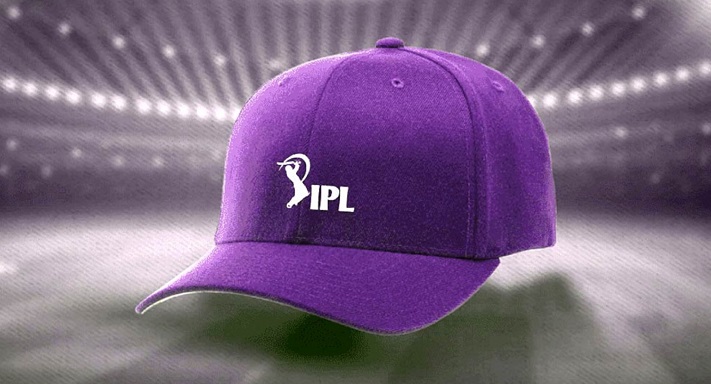|
Listen to this article
|
In professional sports, there are symbolic awards. It’s not just about the cups that the championship winner takes away. In addition to the main cups, there are also many additional titles and awards.
In the IPL, one of the most prestigious is the Purple Cap. This is an award given to the best bowler at the end of the season. Its significance is so great that bookmakers usually offer bets on which cricketer will win the Purple Cap this season.
What is the Purple Cap?
The Purple Cap is an award given to the leading wicket-taker in a particular season of the Indian Premier League (IPL). The bowler who takes the most wickets during the tournament wears the Purple Cap as a symbol of being the highest wicket-taker.

Throughout the IPL season, the Purple Cap is awarded and reassigned to the bowler with the highest number of wickets. It serves as a way to recognize and appreciate the top-performing bowlers in the league. It adds an extra element of competition among the bowlers and makes the tournament more exciting for fans.
How To Get The Purple Cap: Requirements
The Purple Cap in the Indian Premier League (IPL) is awarded to the leading wicket-taker of the tournament. Here’s how the winner of the Purple Cap is determined:
- Throughout the Season: As the IPL season progresses, bowlers take wickets in various matches. The bowler with the highest number of wickets at any given point during the tournament will get the Purple Cap.
- Criteria: The primary criteria for determining the winner of the Purple Cap is the total number of wickets taken by a bowler. If two or more bowlers have the same number of wickets, other factors like the economy rate may be considered to decide the winner.
- Symbolic Recognition: It’s important to note that the Purple Cap is more of a symbolic recognition than a physical cap. The bowler leading the wicket-taking charts may be presented with a purple-colored cap during matches, off-field events, or post-match presentations. However, they do not wear it while playing.
- Season-Long Recognition: The Purple Cap is awarded throughout the entire IPL season, and the bowler who holds the cap at the end of the tournament is recognized as the leading wicket-taker of that season.

At the end of the season, at the award nominations, IPL representatives present awards to the best players of the season. The Purple Cap is also awarded in this ceremony. Along with the cap, the player also receives a check for a cash prize in addition to the title.
The History of the Prize
The concept of the Purple Cap was introduced in the Indian Premier League (IPL) to recognize and reward the leading wicket-taker of each season. The Purple Cap was first introduced in the inaugural season of the IPL in 2008. It was a way to add an individual performance element to the team-centric nature of the tournament and to celebrate the outstanding performances of bowlers.
The person credited with introducing the Purple Cap concept is the IPL governing council, which is responsible for overseeing and managing various aspects of the tournament. The governing council, consisting of representatives from the Board of Control for Cricket in India (BCCI) and other stakeholders, plays a crucial role in shaping the rules, format, and awards associated with the IPL.

Since its inception, the Purple Cap has become a prominent and eagerly watched aspect of each IPL season. It adds an extra layer of excitement and competition among the bowlers, with players striving to be the leading wicket-taker and earn the prestigious cap.
The List of The Holders Of Purple Cap In All IPL History 2008-2023
For the 16 IPL seasons (from 2008 till 2023 included) 13 cricketers won the Purple Cap. Two of them have taken that award twice. Here is the full list of the Purple Cap owners season by season, with their team names and their results:
| Year | Player | Team | Wickets |
| 2023 | Mohammed Shami | Gujarat Titans | 28 |
| 2022 | Yuzvendra Chahal | Rajasthan Royals | 27 |
| 2021 | Harshal Patel | Royal Challengers Bangalore | 32 |
| 2020 | Kagiso Rabada | Delhi Capitals | 30 |
| 2019 | Imran Tahir | Chennai Super Kings | 26 |
| 2018 | Andrew Tye | Kings XI Punjab | 24 |
| 2017 | Bhuvneshwar Kumar | Sunrisers Hyderabad | 26 |
| 2016 | Bhuvneshwar Kumar | Sunrisers Hyderabad | 23 |
| 2015 | Dwayne Bravo | Chennai Super Kings | 26 |
| 2014 | Mohit Sharma | Chennai Super Kings | 23 |
| 2013 | Dwayne Bravo | Chennai Super Kings | 32 |
| 2012 | Morne Morkel | Delhi Daredevils | 25 |
| 2011 | Lasith Malinga | Mumbai Indians | 28 |
| 2010 | Pragyan Ojha | Deccan Chargers | 21 |
| 2009 | RP Singh | Deccan Chargers | 23 |
| 2008 | Sohail Tanvir | Rajasthan Royals | 22 |
IPL 2023 Purple Cap Rank
And here is the table with the players’ results from the IPL 2023. As we can see, Mohammed Shami was just one step from his opponents, but both of them were his teammates.
| Place | Player | Team | Wickets | Runs | Average |
| 1 | Mohammed Shami | GT | 28 | 522 | 18 |
| 2 | Mohit Sharma | GT | 27 | 361 | 13 |
| 3 | Rashid Khan | GT | 27 | 552 | 20 |
| 4 | Piyush Chawla | MI | 22 | 495 | 22 |
| 5 | Yuzvendra Chahal | RR | 21 | 432 | 20 |
| 6 | Tushar Deshpande | CSK | 21 | 564 | 26 |
| 7 | Ravindra Jadeja | CSK | 20 | 431 | 21 |
| 8 | Varun Chakaravarthy | KKR | 20 | 429 | 21 |
| 9 | Mohammed Siraj | RCB | 19 | 375 | 19 |
| 10 | Matheesha Pathirana | CSK | 19 | 371 | 19 |
Conclusion
The Purple Cap is a symbolic award given at the end of each IPL season to the bowler who takes the most wickets. If two players have the same number of points, the player with the better average wins the award.
The cap has been awarded to the best cricketers every season since 2008. This is an individual award that does not depend on the team’s results in the standings. In addition to the Cap, the winner receives a cash prize. Betting is placed on which player will receive the Cap during the season.
IPL Orange Cap & Purple Cap In 2008-2023 Video
FAQ
What is the difference between Orange and Purple Caps in IPL?
The Purple Cap is awarded to the leading wicket-taker in the IPL. While the Orange Cap goes to the leading run-scorer, highlighting the batsman with the most runs. Both are dynamic awards based on season-long individual performances.
What is the price of the Purple Cap in IPL?
Each season, the holder of the Purple Cap has taken the money prize added to the Cap. The size of the prize is growing year by year. In 2023, Mohammed Shami got 15 Lakh (around $18 000).
How is the Purple Cap calculated?
The Purple Cap in IPL is awarded to the bowler with the highest total number of wickets taken throughout the season.
Can there be two Purple Cap owners in one season?
No. One season = one Purple Cap. If two or more players have the same number of wickets, the award is awarded to the player with the best bowling average.
Who won the Purple Cap 2023?
Mohammed Shami from Gujarat Titans, with 28 wickets.
Who won the first Purple Cap in the IPL?
Sohail Tanvir in 2008, played for Rajasthan Royals.
What are the most wickets of the Purple Cap owners?
32 wickets by Dwayne Bravo (CSK, 2013) and by Harshal Patel (RCB, 2021).
Who has the most Purple Caps in IPL history?
Dwayne Bravo (Dwayne Bravo, in 2013 and 2015) and Bhuvaneshwar Kumar (Sunrisers Hyderabad, 2016 and 2017). Both of them had that award twice.
What IPL team has the most Purple Caps?
Purple Cap is an individual award for the player. Most often, the Purple Caps were won by players in the CSK squad: four times. It was Dwayne Bravo (2013, 2015), Mohit Sharma (2014), and Imran Tahir (2019).

Satish, a prolific author hailing from India, has become a prominent figure in the world of online sports betting. With a deep passion for both sports and data analysis, he has carved out a niche for himself as a trusted source of information and insights in the ever-evolving landscape of sports betting.
Satish’s articles are known for their in-depth analysis, statistical rigor, and keen eye for emerging trends, making him a sought-after authority in the field. His work not only informs but also empowers sports enthusiasts and bettors, providing them with valuable knowledge to make informed decisions in the world of online sports wagering.
